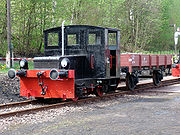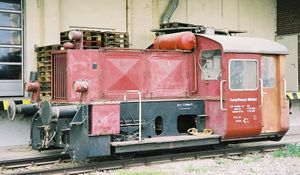
Kleinlokomotive
Encyclopedia


Locomotive
A locomotive is a railway vehicle that provides the motive power for a train. The word originates from the Latin loco – "from a place", ablative of locus, "place" + Medieval Latin motivus, "causing motion", and is a shortened form of the term locomotive engine, first used in the early 19th...
of small size and low power for light shunting duties at railway stations and on industrial railways. It is usually powered by a diesel engine
Diesel engine
A diesel engine is an internal combustion engine that uses the heat of compression to initiate ignition to burn the fuel, which is injected into the combustion chamber...
. However Kleinloks with steam
Steam locomotive
A steam locomotive is a railway locomotive that produces its power through a steam engine. These locomotives are fueled by burning some combustible material, usually coal, wood or oil, to produce steam in a boiler, which drives the steam engine...
, petrol or electric engines
Electric locomotive
An electric locomotive is a locomotive powered by electricity from overhead lines, a third rail or an on-board energy storage device...
were also produced.
After testing several trials locomotives, the Deutsche Reichsbahn
Deutsche Reichsbahn
Deutsche Reichsbahn was the name of the following two companies:* Deutsche Reichsbahn, the German Imperial Railways during the Weimar Republic, the Third Reich and the immediate aftermath...
(DRG) placed various types of such locomotives into service from 1930 onwards. Industrial lines and railway workshops generally procured the engines of the same design.
In Switzerland Kleinlokomotiven were used as light rail motor tractors.
History
In order to speed up goods traffic and to meet the challenges posed by the emerging competition from road traffic, various national railways in Europe carried out trials from 1923 onwards with small diesel-powered shunters. Until then all shunting movements for goods wagons at small stations and loading yards had to be carried out by the locomotive in charge of the local goods train (Nahgüterzug). This extended waiting times and reduced the average speed of the train considerably . Having a dedicated shunting engine at such stations would not have been economic due to the low levels of goods traffic. The development of combustion-engined locomotives offered new possibilities here: the Kleinlokomotiven were smaller, cheaper and easy to operate. It was anticipated that the resulting improvement in the speed at which goods could be moved would enable the railways to compete with road transport.The first trials - in 1923 by the French Eastern Railway, in 1925 by the Danish State Railway
Danske Statsbaner
DSB, an abbreviation of Danske Statsbaner , is the largest Danish train operating company, and the largest in Scandinavia. While DSB is responsible for passenger train operation on most of the Danish railways, goods transport and railway maintenance are outside its scope...
, in 1926 by the Dutch Railways
Nederlandse Spoorwegen
Nederlandse Spoorwegen , or NS, is the principal passenger railway operator in the Netherlands.Its trains operate over the tracks of the Dutch national railinfrastructure, operated by ProRail, which was split off from NS in 2003...
and finally in 1927 by the Reichsbahn
Deutsche Reichsbahn
Deutsche Reichsbahn was the name of the following two companies:* Deutsche Reichsbahn, the German Imperial Railways during the Weimar Republic, the Third Reich and the immediate aftermath...
- were very promising.
As a result, in 1930, the Deutsche Reichsbahn issued the first orders for a total of 18 trials locomotives to various manufacturers. A 1927 shunting unit delivered by the Berliner Maschinenbau AG
Berliner Maschinenbau
Berliner Maschinenbau AG was a German manufacturer of locomotives.The factory was founded by Louis Victor Robert Schwartzkopff on 3 October 1852 as Eisengießerei und Maschinen-Fabrik von L. Schwartzkopff in Berlin ....
to the Dutch State Railways served as a prototype.
These vehicles were very different from one another, and their performance varied too. For its subsequent orders, in 1931 and 1932, the DRG specified the dimensions and divided the locomotives into two power categories – locomotives with an engine power output of up to 40 PS (29 kW) were allocated to power group I
DRG Kleinlokomotive Class I
The Kleinlokomotiven of Class I were light German locomotives of low weight and power designed for shunting duties. They were placed in service by the Deutsche Reichsbahn after trials had been carried out on several prototype locomotives in 1930...
and more powerful locomotives to power group II
DRG Kleinlokomotive Class II
German Kleinlokomotiven like the DRG Kö II were developed as locomotives with a low weight and driving power for light shunting duties. There were two classes, based on engine power...
. Based on its experience with the earlier engines, the Kleinlokomotiven were then standardised by the DRG as Einheitskleinlokomotive (standard small locomotives).
DRG classification system
The first Kleinloks to be completed in 1930 were initially given the letter class V for Verbrennungsmotor (combustion engine) or A for Akkumulatorlokomotive (accumulator or battery-driven locomotive) followed by a serial number, beginning at 6000.To make a better distinction between the various types of Kleinlokomotiven, the Deutsche Reichsbahn
Deutsche Reichsbahn
Deutsche Reichsbahn was the name of the following two companies:* Deutsche Reichsbahn, the German Imperial Railways during the Weimar Republic, the Third Reich and the immediate aftermath...
(DRG) introduced a new system in 1931, as part of which the concept of a Kleinlokomotive was first unequivocally laid down. Traction engines that only worked in railway workshops or at repair shops (Ausbesserungswerken) were not counted as Kleinlokomotiven.
The class letter K was now used to identify them. This was followed by a letter indicating the type of engine: b stood for petrol engine (Benzol, lit: "benzene"), d for steam engine (Dampfmaschine), ö für diesel engine (Öl, i.e. oil) and s for a battery-driven electric engine (Speicher, i.e. accumulator battery). The next letter indicated the type of transmission: e for electric power transmission (Elektrogetriebe) and f for hydraulic transmission (Flüssigkeitsgetriebe). Kleinlokomotiven with purely mechanical transmission were not given a specific third letter and those whose batteries were charged by a diesel or petrol engine were classified as Köe and Kbe respectively.
These letters were followed by a four-figure number, which indicated the power of the Kleinlok. Locomotives in power group (Leistungsgruppe) I were given numbers up to 3999; locomotives in power group II numbers from 4000 onwards. The numbers ran sequentially within each group.
In 1944 the letter g was introduced for locomotives powered by generator gas (Generatorgas).
Like the other DRG classification schemes, the classfication for Kleinlokomotiven was retained by the Deutsche Bundesbahn
Deutsche Bundesbahn
The Deutsche Bundesbahn or DB was formed as the state railway of the newly established Federal Republic of Germany on September 7, 1949 as a successor of the Deutsche Reichsbahn-Gesellschaft '...
(DB) and the Deutsche Reichsbahn after the Second World War.
In 1955, the Deutsche Bundesbahn raised the boundary between power groups I and II from 40 PS to 50 PS. In 1956 a new power group III
DB Class Köf III
The DB railways Köf III class are light two axle shunting locomotives of Deutsche Bahn AG.-History:...
was introduced for Kleinlokomotiven with an engine power output over 150 PS and they were allocated operating numbers from 10000 to 20000. In 1960 the code letter s was changed by the Deutsche Bundesbahn to an a.
1968 DB numbering scheme (West Germany)
From 1 January 1968, Kleinlokomotiven in the DB were places into new classes in the 300 series. The second figure indicated the power class (based on the 1955 groups). The third digit varied depending on top speed and the type of brake or drive (chain drive or Gelenkwellenantrieb). Ka locoomotives were allotted to classes 381 (pre-war types) and 382 (newer types). The existing narrow gaugeNarrow gauge
A narrow gauge railway is a railway that has a track gauge narrower than the of standard gauge railways. Most existing narrow gauge railways have gauges of between and .- Overview :...
Kleinlokomotiven on the Wangerooge Island Railway
Wangerooge Island Railway
The single track Wangerooge Island Railway is an unelectrified narrow gauge railway with a rail gauge of 1,000 mm located on the East Frisian island of Wangerooge off the northwestern coast of Germany...
were grouped into Class 329.
In 1987 the DB Class 260/261
DB Class V 60
The DB Class V 60 is a German diesel locomotive operated by the Deutsche Bundesbahn and later, the Deutsche Bahn AG , which is used particularly for shunting duties, but also for hauling light goods trains. Seventeen locomotives were bought used by the Norwegian State Railways and designated NSB...
diesel locomotive (the pre-1968 Class V 60) was classed as a Kleinlokomotive, in order that it could be crewed by shunting staff, who had not been trained to work locomotives on the open line. They were consequently reclassified as 360/361 engines.
1970 DR numbering scheme (East Germany)
The DR's new numbering plan, introduced on 1 July 1970, placed all existing Kleinlokomotiven into Class 100, i.e. into the standard range of numbers for combustion-engined locomotives. Locomotives in power group I became sub-class 100.0, locomotives in power group II went into sub-classes 100.1–100.9. The narrow gauge Kleinloks of both power groups were also grouped into sub-class 100.9 until 1972, but were then moved to Class 199.Prior to 1970, however, newly built Kleinlokomotiven in the DR had not been given the class letter K, but were allocated e.g. to Class V 15 (later 101).
In the DB/DR common numbering scheme of 1992, the DR's Class 100 locomotives became Class 310.
See also
- DRG Kleinlokomotive Class IDRG Kleinlokomotive Class IThe Kleinlokomotiven of Class I were light German locomotives of low weight and power designed for shunting duties. They were placed in service by the Deutsche Reichsbahn after trials had been carried out on several prototype locomotives in 1930...
- DRG Kleinlokomotive Class IIDRG Kleinlokomotive Class IIGerman Kleinlokomotiven like the DRG Kö II were developed as locomotives with a low weight and driving power for light shunting duties. There were two classes, based on engine power...
- DB Class Köf IIIDB Class Köf IIIThe DB railways Köf III class are light two axle shunting locomotives of Deutsche Bahn AG.-History:...
- DB Class V 60DB Class V 60The DB Class V 60 is a German diesel locomotive operated by the Deutsche Bundesbahn and later, the Deutsche Bahn AG , which is used particularly for shunting duties, but also for hauling light goods trains. Seventeen locomotives were bought used by the Norwegian State Railways and designated NSB...
- DR Class V 60

